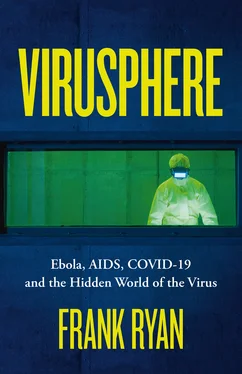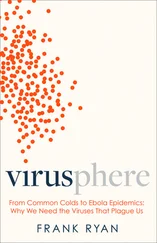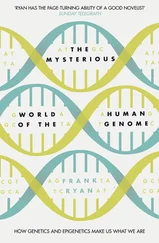The key fact here is that rubella, like measles and mumps, is exclusive to humans. It means that we are the only reservoir or host of all three viruses – in the symbiological lexicon, we are the exclusive partner. That means that if the reservoir were to be closed down, for example through vaccination, the diseases would disappear.
The risk of all three of these viruses – measles, mumps and rubella – has been greatly reduced in developed countries by preventive vaccination, which, in the UK, the US and many other countries, is achieved using the combined MMR vaccine. It is important, given various misinformation scares, that we grasp the purpose of such a vaccine, and indeed the way in which vaccination works.
Vaccines use either a live, but harmless, variant of a live virus, or a killed virus – or even antigens extracted from parts of a virus – to protect children from the suffering and potential complications of virus infection. The MMR triple vaccine, which employs all three live attenuated viruses – measles, mumps and rubella – has greatly reduced the prevalence of all three viral diseases in the countries where it has been introduced. Unfortunately, a scientifically disproven claim that the MMR vaccine increases the risk of autism has persuaded some parents to forgo vaccinating their children.
People really do need to sit up and take notice of the advice of doctors and health authorities and ignore the misinformation coming from unreliable sources. Not doing so has the potential for unpleasant consequences. In a recent case involving the Somali-American community in the state of Minnesota, the local population, being misguided into believing that the vaccine had increased the frequency of autism in their children, stopped vaccinating their children with MMR. The real truth was exposed by a joint study by the University of Minnesota, the Centers for Disease Control in Atlanta, and the US National Institutes of Health, which showed that the incidence of autism in the Somali-Americans was no different from the vaccinated city’s white population. Alas, in May 2017 Minnesota saw the biggest outbreak of measles in the state for 27 years. State officials recommended that the Somali children be protected as soon as possible with vaccination booster shots.
America is far from alone in the resurgence of this dangerous and highly infectious disease of childhood. In May 2018, the British newspaper, the Daily Telegraph , reported a resurgence of measles throughout the continent of Europe, with the disease increasing in Belgium, Portugal, France and Germany. Once again, the efficacy of MMR vaccination was being undermined by the same baseless linking of the measles vaccine to autism, which had resulted in a rise from a record low incidence of measles Europe-wide, with 300 per cent rise in cases from 2017 to an estimated 21,000 cases in 2018, and some 35 reported deaths. In the UK, following years of similar misinformation about a link between the MMR and autism, many people of late teenage years to early twenties had not been vaccinated in their childhood years, making them now susceptible to this unpleasant and potentially dangerous viral infection. In July 2018 The Times reported a national alert being sounded out to family doctors throughout the UK, warning them to be on the alert for the disease in families returning from holidays in Italy. In England alone some 729 cases had already been reported in the first half of the year, when compared to 274 in the whole of the previous year.
Parents with any due concerns should seek the advice of their knowledgeable family doctors.
5 5. A Bug Versus a Virus 6. A Coincidental Paralysis 7. Deadly Viruses 8. An All-American Plague 9. Lurker Viruses 10. How Flu Viruses Reinvent Themselves 11. A Lesson from a Machiavellian Virus 12. The Mystery of Ebola 13. The Mercurial Nature of the Zika Virus 14. A Taste for the Liver 15. Warts and All 16. Lilliputian Giants 17. Are Viruses Alive? 18. Inspiring Terror – and Delight 19. The Ecology of the Oceans 20. The Virosphere 21. The Origins of the Placental Mammals 22. Viruses in the Origins of Life 23. The Fourth Domain? Bibliography and References Index About the Book About the Author Also by Frank Ryan About the Publisher
A Bug Versus a Virus Contents Cover Title Page Copyright Dedication Epigraph Introduction 1. What Are Viruses? 2. Coughs and Sneezes Spread Diseases 3. A Plague Upon a Plague 4. Every Parent’s Nightmare 5. A Bug Versus a Virus 6. A Coincidental Paralysis 7. Deadly Viruses 8. An All-American Plague 9. Lurker Viruses 10. How Flu Viruses Reinvent Themselves 11. A Lesson from a Machiavellian Virus 12. The Mystery of Ebola 13. The Mercurial Nature of the Zika Virus 14. A Taste for the Liver 15. Warts and All 16. Lilliputian Giants 17. Are Viruses Alive? 18. Inspiring Terror – and Delight 19. The Ecology of the Oceans 20. The Virosphere 21. The Origins of the Placental Mammals 22. Viruses in the Origins of Life 23. The Fourth Domain? Bibliography and References Index About the Book About the Author Also by Frank Ryan About the Publisher
One of the commonest errors people make in relation to microbes is to confuse viruses with bacteria. It is important that we recognise the differences since this is the first step towards understanding the vital role of the interactions between the two very different organisms – bacteria and viruses – in the great ecological cycles that are central to life on the planet. One of the commonest of bacterial species found in the healthy colon of mammals is Escherichia coli , usually diminished to E. coli . The most widely studied bacterium in laboratory experiments, E. coli is also an important member of the symbiotic gut bacteria, helping in the production of vitamin K and the digestive uptake of vitamin B12, meanwhile also helping to reduce the threat of invading pathogenic bacteria. E. coli colonises the baby’s gut within 40 hours of birth, gaining access through hand-to-mouth human contact – most likely the mother during her fondling and feeding of the child. This, of course, is no threat, but rather the beginning of an important symbiotic interaction between human and bacterium.
The E. coli species is divided into a number of serotypes, most of which are either harmless or symbiotic to humans. This is why contamination of the skin with human waste is a question of hygiene rather than a cause for alarm. However, there are pathogenic serotypes of E. coli that can cause gastroenteritis, and these serotypes may be involved in food scares and product withdrawal from food outlets. More virulent strains of the pathological serotypes can cause urinary tract infections and, rarer still, life-threatening bowel necrosis, peritonitis, septicaemia and fatal cases of haemolytic-uraemic syndrome. Thankfully these serotypes are very rare, so that, under normal circumstances, E. coli is a beneficial contributor to the human gut flora.
Under the light microscope, the bacterium is visible as a single-celled sausage-shaped bacterium roughly 2.0 micrometres long. A micrometre, or μm, is one-millionth of a metre. E. coli has no nucleus and so it is an example of a prokaryote, which translates from the Greek to mean ‘before nucleated life forms’. The bacterial body is enclosed in a membrane, or cell wall, which contains the protein antigens that separate it into different serotypes. The cell wall does not take up the commonly used dye for testing bacterial types, known as a Gram stain, so it is classified as Gram-negative. This same cell wall is capable of acting as a barrier to certain antibiotics, so for example E. coli is resistant to the action of penicillin. Many strains of the bug have flagella and so they can be seen to wriggle about in search of nourishment. The bug is attuned to living in the anaerobic environment of the human intestine, where it sticks on tight to the microvilli of the intestinal wall. When passed out of the body, in faeces, the bug is capable of surviving for some time even when exposed to the oxygenated environment. This is why pathological serotypes can cause food contamination in the home and in food-processing environments.
Читать дальше












